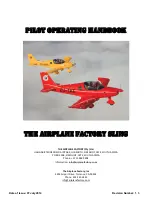
Aircraft Alternator
Maintenance Manual
ES1031
24-30-01
Rev. B: 20 Apr. 2022
Page: 6-1
© 2022 - Hartzell Engine Technologies - All rights reserved
CHAPTER 6 - MAINTENANCE
6.1 General
A. This section contains information regarding recommended maintenance for all alternators listed in this
manual. These recommendations assure reliable and safe operation of the alternator while in service.
Maintenance is listed in hours time in service (TIS) or calendar time, whichever is applicable but each are the
first to occur. Some maintenance is one time initial and others are recurring. Refer to Chapter 4, “Checks” for
required inspections.
A. HET recommended maintenance, checks and TIS may be superseded by the aircraft or engine
manufacturers established time limits and schedules based on experience and/or unique requirements
under it’s Type Certificate or other certifications.
6.2 Bi-Annual Maintenance
A. The electrical charging system should be inspected at regular intervals, the frequency of which should be
determined by the type of service and the conditions under which the aircraft is operated. It is recommended
that the following inspection/maintenance be made each six months and should include:
Note:
The FAA requires a battery capacitance check at annual (12 month) intervals. Checks may coincide
with each annual inspection. Some battery manufacturers suggest more frequent checks. Refer to
the aircraft manufacturers maintenance manual or service information.
(1)
Battery
- The lead-acid type battery should be checked with a hydrometer to ensure that it is fully
charged and filled to the proper level with approved water. Perform a battery capacitance check using
an aircraft battery capacitance tester to determine battery condition. Check for dirt and corrosion and
clean. If other types of battery are used, follow the specific instructions of the battery manufacturer.
(Refer to note above.)
(2)
Wiring
- The alternator circuit should be inspected to insure that all connections are clean and tight
including the battery, field and regulator terminals. The insulators must be sound.
(3)
Lubrication
- No lubrication is required on the alternator except at the time of overhaul.
(4)
Drive Coupling
- The drive coupling is a component supplied by the airframe or engine manufacturer. It
provides protection to the engine gears and alternator. It should be checked as specified by the engine
manufacturer or upon any reduction of alternator output when no cause is apparent. Refer to the engine
or airframe manufacturers maintenance manual or service information (as applicable).
(5)
Drive Belt
- The drive belt is a component supplied by the engine or airframe manufacturer. It
should be checked at any maintenance event for condition and replaced as needed or at the engine
or airframe manufacturers recommended TIS. Refer to the engine or airframe maintenance manual
or service information (as applicable).
(6)
Operation
- Operate the alternator at a light load (10 amps or less) and note a steady operation with little
or no radio noise. If noise exists, the brushes may be worn, the slip rings dirty, a bonding problem, or a
failed alternator filter (if so equipped). Operate at max load and observe the output to be at the rated
power with little or no radio noise. Loss of power or radio noise may indicate problems with the rectifiers
as well as worn brushes or damaged or dirty slip rings.











































